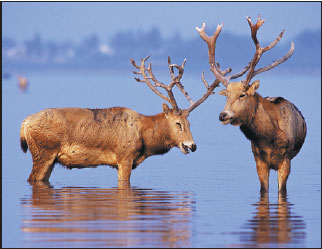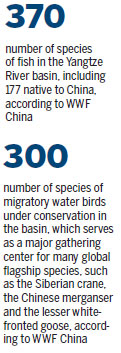Conservation efforts boost Yangtze River wetland
|
Twomilu, or Pere David's deer, feed on wetland in the Tian'ezhou Milu National Nature Reserve in Hubei province.Song Jianchun / For China Daily |
Bird sanctuaries and businesses benefit from environmental protection project. Chen Liang and Li Yingqing report from Dali, Yunnan province.
The patrol teams at the Shanghai Chongming Dongtan National Nature Reserve need just three essential pieces of equipment for their daily work: a telescope; a pair of binoculars; and a smartphone fitted with an app developed by the reserve.
Every morning, the patrol teams gather in the reserve's office on Chongming Island in the Yangtze River estuary to identify their planned routes and start work.
They use the equipment to record the numbers and species of birds, traces of animal life and any evidence of illicit human activity, such as cattle herding, that they observe along their route. The app transfers the field data to the reserve's computers as soon as it is entered into the phone.
The technology gives the managers in the office a clear picture of everything that's happening in the reserve. "All the data is analyzed regularly so we can discover problems, solve them and improve our management over time," said Tang Chendong, the reserve's director, at the 10th annual meeting of Yangtze Wetland Protected Area Network, held in Dali, Yunnan province, last month.
Tang outlined Dongtan's experiments in wetland conservation and reserve management to about 300 delegates from the State Forestry Administration, and wetland management authorities from 29 provinces, municipalities and autonomous regions. International organizations also attended including the World Wide Fund for Nature, and research institutes and universities.
Extensive scale
Tang was one of 12 keynote speakers at the meeting, which was organized by the SFA's Wetland Management Center, WWF China, the UN Development Programme China and the Yunnan Forestry Bureau.
During the meeting, which also acted as a training seminar for participants from the network's 252 members - mostly wetland reserves and parks within the Yangtze River basin - the delegates discussed how to put the Yangtze River wetland under "extensive protection".
Speaking at a forum earlier this year, President Xi Jinping said the restoration of the Yangtze River ecosystem should be made "an overwhelming priority" and urged experts to "focus on extensive protection" of the 6,300-km-long river.
"Extensive protection of the Yangtze wetland is key to realizing the country's goal that 'the area of wetland in China should not fall below 800 million mu (53.33 million hectares)'," said Chen Fengxue, the SFA's deputy director. Protection and restoration of the wetland along the Yangtze River is considered an important way of implementing the national strategy to build an economic belt along the river, he said.
The economic belt covers Shanghai and Chongqing, and nine provinces - Jiangsu, Zhejiang, Anhui, Jiangxi, Hubei, Hunan, Sichuan, Yunnan and Guizhou - across an area of more than 2 million square kilometers.
At present, 18 Ramsar sites (wetland designated as internationally important), 167 wetland reserves and 291 national wetland parks have been established to manage 11.54 million hectares within the belt.
"They form a comparatively complete wetland conservation system," Chen said.



























